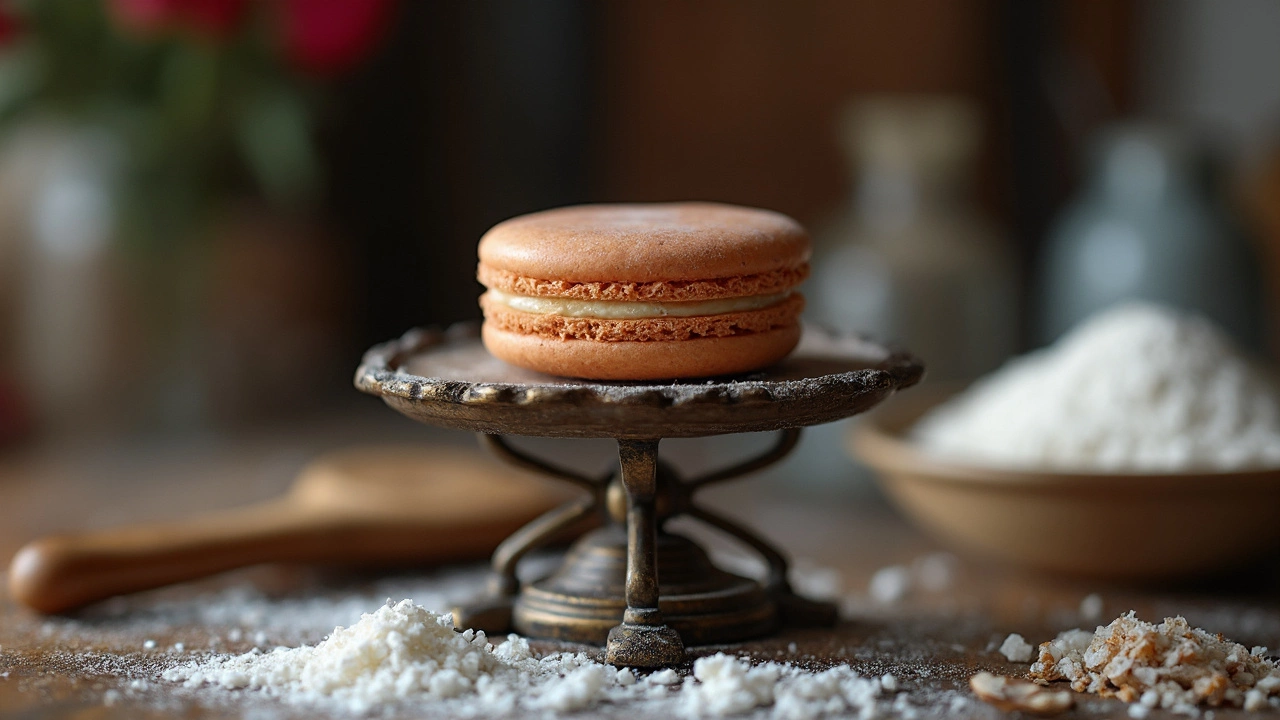
Ever wondered just how much a single macaron weighs? You're not alone! These tiny, airy delights often weigh in at around 10 to 15 grams each. But why the variation? It's all about the size of the cookie and the filling choices. If you're baking at home, this might help you get a handle on how many ingredients you really need.
When you're whipping up a batch of these French delicacies, being precise with weight can actually make or break your final product. Too dense, and they're just not the same, too light, and you're left with crumbs. If you're aiming for that perfect macaron, understanding the ideal weight gives you a step up in the kitchen.
- Understanding macaron weight
- Factors affecting macaron weight
- Macaron weight in baking
- Tips for consistent sizing
- Macaron myths debunked
Understanding Macaron Weight
Alright, so let's get into the nitty-gritty of macaron weight. Typically, a single macaron weighs between 10 to 15 grams. Why does this matter? For one, consistency is key in baking, especially for delicate treats like macarons. If your macarons are all over the place in terms of weight, they might not bake evenly, which can affect the texture and taste.
Now, you might be thinking, 'How much can a few grams really matter?' Well, in the land of macarons, a lot! The average macaron shell alone weighs about 5 to 6 grams, with the filling making up the rest. Whether you're using buttercream, ganache, or jam, each filling brings its own density and weight into play.
Why Weight Varies
Several factors can cause fluctuations in macaron weight. Size is the obvious one; larger macarons will, of course, weigh more. But other factors include the humidity of the kitchen and the recipe itself. Macarons made with almond flour might differ slightly from those using alternative flours.
| Ingredient | Average Contribution to Weight |
|---|---|
| Macaron Shell | 5-6 grams |
| Filling | 5-9 grams |
Monitoring Weight for Perfect Baking
To keep your macarons within that 10 to 15-gram range, try weighing your ingredients meticulously. This small step can save you the pain of batter that spreads too thin or a filling that's more than you bargained for. Some bakers even go as far as weighing out their batter per macaron to ensure they bake uniformly.
So the next time you bite into one of these tasty morsels, you'll know just how much science (and a few grams!) went into creating that perfect balance of flavor and texture.
Factors Affecting Macaron Weight
When it comes to figuring out the weight of a macaron, several factors come into play. It's not just about the recipe but also how it's executed. Let's break it down.
1. Shell Size
The size of the macaron shell is probably the biggest factor. A standard macaron is around 3-4 centimeters in diameter, but some bakers go bigger or smaller. Naturally, this impacts how much each macaron weighs. It's all in the piped batter's quantity.
2. Filling Type and Amount
Fillings vary widely and affect weight too. A light ganache won't contribute as much to the total weight as a hefty dollop of buttercream. Plus, some folks like them packed while others prefer a thinner smear. Finding the right balance makes all the difference in those grams.
3. Humidity Control
Believe it or not, the environment is crucial when making macarons. Humidity affects drying time and can even alter the final texture. Too much moisture during or after baking can add unwanted grams, throwing off your measurements and texture.
4. Ingredients Consistency
The consistency of your batter impacts weight. Over-mixing or under-mixing your egg whites can alter the structure, and ultimately the macaron weight. Making sure your batter has the right consistency is crucial for a consistent result.
5. Baking Time and Temperature
Even slight variations in oven temperature or bake time can lead to different weights. Too long or too hot, and you lose moisture, making them lighter. Too short or cool, and they're heavier or undercooked.
Understanding these factors helps achieve that perfectly balanced macaron, consistently weighting in that sweet spot of 10 to 15 grams. Mastering these variables takes practice, but once you do, you'll be making professional-grade macarons in your own kitchen.

Macaron Weight in Baking
When you're in the kitchen, the weight of your macarons isn't just a trivial detail—it's an essential factor that can significantly impact their outcome. The right weight ensures your macarons bake evenly and fit perfectly into those little boxes for gifting or displaying at a party.
The Role of Weight in Perfect Macarons
Why is macaron weight so crucial? It comes down to consistency. Each macaron should look and taste as similar as possible, so weighing them can help your batch stay consistent. On average, aim for about 10 to 15 grams per macaron shell before filling.
When you're filling them, remember that this adds to the overall grab. Common fillings like ganache, jam, or buttercream can vary in weight. For best results, make sure your finished macaron size stays around the typical heft when paired with its buddy.
Useful Steps to Get It Right
- Measure batter carefully: Use a kitchen scale to portion out uniform dollops of batter. This helps manage weight consistency.
- Mind your filling: Opt for lighter fillings if your shells are on the heavier side to maintain that 10-15 grams balance.
- Bake evenly: Rotate your baking tray halfway through cooking to ensure even heat distribution.
Macaron Weight Tips for Bakers
Here are some handy tips:
- Use a reliable scale: Digital scales with precision to the gram work best.
- Uniform shells ensure even baking: Aim for equal-sized halves to pair up neatly.
- Adjust when needed: Remember, humidity and room temperature can affect batter weight.
Being mindful of how many grams a macaron weighs can take your baking skills up a notch and make sure your treats always come out picture-perfect!
Tips for Consistent Sizing
Getting every macaron to be just the right size isn't just luck. Here are some tips that can help you achieve that perfect, uniform look every single time.
Use a Template
If you're serious about keeping your macarons the same size, a template is a game changer. Simply slide it under your baking paper and pipe directly above it. This way, each cookie gets the same size right from the start! You can find printable macaron templates online, or you can make your own using circles drawn on parchment paper.
Use a Scale
For the filling, consistency is key. It's not enough to spoon it out and hope for the best. Weighing each portion ensures your macarons are symmetrical and not overloaded. Ideally, aim for around 5-8 grams of filling per macaron.
Piping Technique Matters
When piping, hold your bag vertically, and aim for the center of your circle. Steady pressure helps to keep the size uniform. Practice makes perfect, and after a few tries, you’ll get the hang of it.
Rest the Mixture
This might sound strange, but resting the batter helps more than you'd think. Once piped, let your macarons sit out until they form a film on top. This can take 20-60 minutes, depending on humidity. This rest period prevents them from spreading too much in the oven.
Consistent Oven Temperature
Having an accurate oven can save your batch from disaster. If your macarons are baked at a consistent temperature, they stay true to their piped size and don't puff up unpredictably.
| Size (Diameter) | Weight Range |
|---|---|
| 3cm | 10-12g |
| 5cm | 15-18g |
Remember, perfecting macaron consistency can take a bit of trial and error. Don’t be discouraged by a few uneven batches. With these tips and a bit of practice, you’ll be a macaron maestro in no time!

Macaron Myths Debunked
When it comes to macarons, there's no shortage of myths swirling around these delicate treats. Let's set the record straight on a few common misconceptions.
Myth 1: Macarons and Macaroons Are the Same
Despite sounding almost identical, macarons and macaroons are totally different. A macaron is a French meringue-based confection made with egg whites, almond flour, and sugar, forming two delicate shells sandwiched with a filling. On the other hand, macaroons are a separate pastry, usually made with shredded coconut.
Myth 2: Macarons Are Always Expensive
It's true that buying macarons from a patisserie can be quite pricey, often $2-$3 each. However, making them at home can significantly cut costs, usually to around $0.40 per macaron! All you need is a bit of practice.
Myth 3: Macarons Are Impossible to Bake at Home
Macarons do have a reputation for being temperamental, but they're not impossible to make at home. Key factors include precise measurements, a gentle folding technique, and knowing your oven's quirks. Once you've mastered these, you'll be churning out batches of macarons like a pro.
Myth 4: All Macarons Have the Same Weight
As mentioned earlier, the weight of a single macaron can vary, typically between 10 to 15 grams. Factors like size, filling, and even baking conditions contribute to this variation. Understanding these can help you maintain consistency.
Myth 5: Macarons Require Expensive Ingredients
While high-quality ingredients can elevate your macarons, they're not necessarily expensive. Almond flour can be homemade by grounding blanched almonds. As for fillings, there are plenty of budget-friendly options, like buttercream or ganache, you can make with pantry staples.
Busting these myths can take the intimidation out of baking and enjoying macarons. With a careful approach and realistic expectations, anyone can master these little delights.